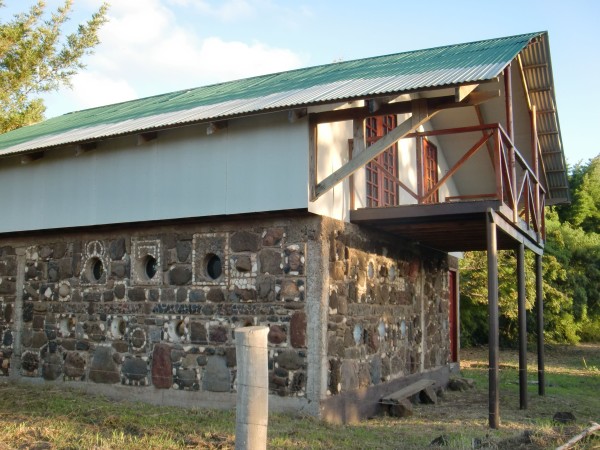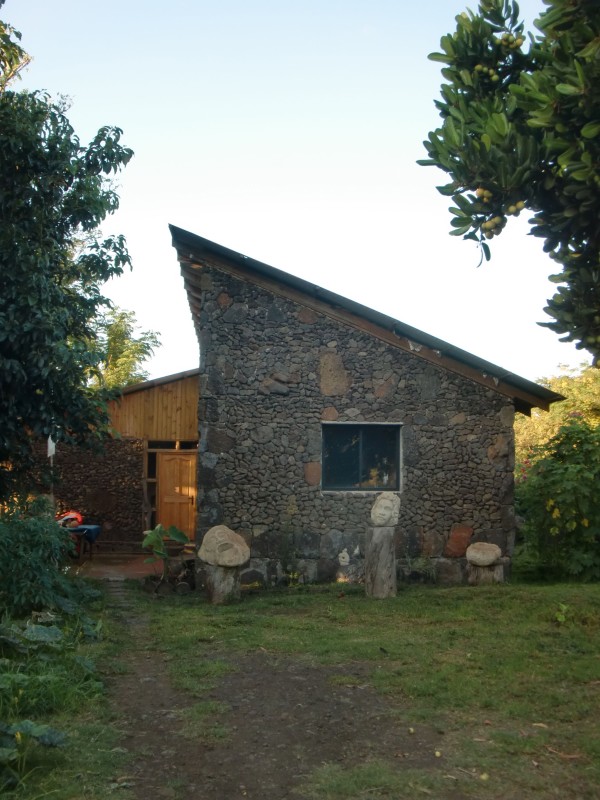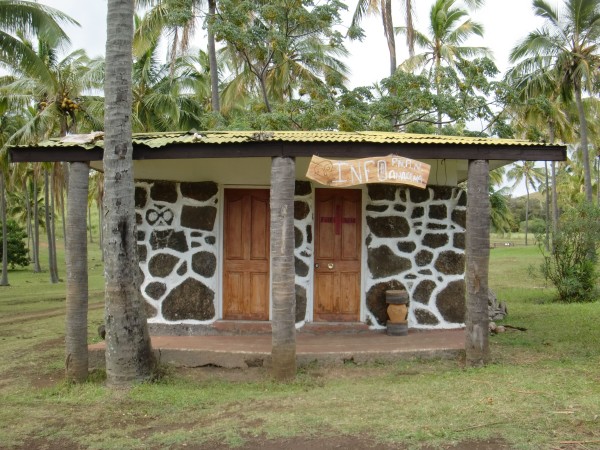When my husband and I told our friends and family we were traveling to Easter Island, many of them were surprised to learn that people actually live on the most remote island on Earth. In fact, about 4,000 beautiful, friendly people live on this magical South Pacific island, and many of them in some interesting, tiny houses.
[/caption]
Easter Island, or Rapa Nui, as it’s called by the locals, is actually a territory of Chile, but many of the people who live there are of Polynesian descent. The 15 mile long island is about 1,300 miles west of mainland Chile and Hanga Roa is the only town on the island. It also contains a small airport, one main paved road and several dirt roads.
The main reason that visitors come to Easter Island is to see the enigmatic moai. These large figures (some nearly 40 feet tall and weighing over 80 tons) were carved around 1100 CE and nearly 900 of them have been counted on the island. They were carved out of solidified volcanic ash by the early Polynesians to represent their ancestors and the first people who discovered the island. Contrary to popular belief, the moai are more than just heads. The figures were carved to show the torso and hands of each person, and the locations and the ways in which they are placed represent their status and where they landed on the island.
Because of the mild, semi-tropical climate on Rapa Nui, many of the homes are open to the outside and have decks or covered patios. Also because of the lack of building materials on the island and the costs of shipping to this remote place, many of the homes are built with local volcanic rock. Several homes we saw were also made out of shipping containers, which are delivered regularly by ships from South America and Asia. Because of their low cost, corrugated metal sheets are used frequently for the homes’ roofs.







Photos by Christina Nellemann
By Christina Nellemann for the [Tiny House Blog]

Neat place! Plus it looks like not many if any cars/4-wheeled vehicles there…my kinda spot
These photos are so cool.
very cool. (I must admit that I had to look up “CE” used behind the date. I have never heard that before.)
Me neither! I’ll have to go look it up now- is it based on a different calendar?
No, it is still based on the Gregorian calendar.
In other cultures, big houses just aren’t necessary. Of course it helps if it is warm out 🙂
ABSOLUTELY A+ for ORIGINALITY in an article – what a refreshing and extraordinary viewpoint!
I am one of those who believed Easter Island was a protected park, with zero to nominal (security, maintenance, staff, etc.) population… It appears the good-sized village therein, however, is populated with good stewards, who not only represent this in their pride and understanding of the moai, but in the craftsmanship of their neat yet personable dwellings, as well.
Nice read. Thank you for sharing!
😉
Thank you jipsi. Yes, the entire island of Rapa Nui is considered a national park and you must purchase a park pass before venturing out of Hanga Roa to visit many of the “ahu”, or sacred areas where the moai stand. It’s a big no-no to touch the moai or stand on any of the ahu. The best way to get around is by quad, motorcycle or on horseback since most of the roads are dirt. Because of the lack of industry (for thousands of miles), traffic and vehicles, the air and light quality of the island is extraordinary.
Barb,
CE and BCE are dating terms the liberals started to use so that there was no trace to religion in dating even though our current dating begins at the time of Jesus, they looked for a way to hide that. Rather than BC (Before Christ) and AD (after death), they have tried to introduce CE (Common Era) and BCE (before common era). Pretty stupid, I know and cinfusing since everyone was not taught the latter. Just one more attempt to take the Creator of life out of what he created again…On the topic of this post though, Kent this place is kind of cool. I knew nothing of this Island before but it seems like it would be a awesom place to relax and unwind! LOVE IT! I love how you never truly run out of ideas for the tiny house blog and that there is always something out there to see and discuss..keep up the good editorial work! I love this page!!
Steve-
Please keep the divisive political to yourself and keep to the subject of ‘Tiny Houses’.
I speak only for myself in that I am tired of polarizing political ‘dicussions’ creeping into every facet of my life.
You could have just as easily stated that the terms CE and BCE stood for ‘Common Era’ and ‘Before Common Era’ without bringing in the terms ‘Liberal’ and ‘they’ into the discussion which only serves to polarize and divide people.
Lastly, the terms ‘CE’ and ‘BCE’ have been in use for decades by publishing houses, scholarly texts, and religious texts.
The reasoning behind the change from the ‘traditional’ BC / AD designators to the current form of CE / BCE is that the Gregorian calendar (western Christian calendar) has been adopted the world over by peoples of different faiths and cultures as a matter of convience in the matters of trade and commerce. Many cultures and faiths still have their own traditional calendars (The Hebrew calendar, Eastern Orthodox, Chinese lunar, etc…) however in an effort to show compassion and understanding to other faiths and cultures who do not recognize / worship Christ but use the Gregorian calendar for reasons stated earlier, a decision was made to drop the terms BC / AD (which techically speaking stands for Anno Domini (Latin)…not after death).
Good day to you.
Aren’t we here to think about Tiny Houses? I don’t understand why people think it’s a forum for their religious and political beliefs.
Let’s stick to the topic. We love the idea of living more simply. Let’s also be more gentle.
Marcia-
I agree with you, we are here to discuss Tiny Houses and not political / religious beliefs. The only time political issues should be discussed here is when it pertains to the Tiny House movement (zoning laws, building codes, etc).
In regards to being ‘more gentle’, I feel that my retort to Steve’s original comment was justified albeit a bit on the stern side. I did however manage to say ‘Please’. 🙂
I always think it is beneficial to learn the accurate history of these terms and how they came about. So much of history has been erased and it benefits no one. Consider that the inhabitants of Easter Island were wiped out, leaving no oral history. No one should be afraid of or offended by the truth.
“Pretty stupid”
The only two words that are correct in the above statement.
Blaming “Liberals” for the incompatable diferent versions of the birth of Jesus is totally uncalled for and only advertise your own narrow and incomplete view of the matter. Different Gospels relate the birth of Jesus somewhat differently and resulted in some theological debate on the matter.
Scholars generally now believe that the birth of Jesus was 4 BCE, others argue that the birth of Christ was called called 1 instead of zero, because early Christians did not consider zero as a valid number. This means birth was 1 BCE, and when Christ was 1 year old the calander would say 2 AD. Consider also that we celebrate the birth of Christ in December not at the New Year.
The Common Era is loosely tied to the birth of Christ but it does NOT mark actual Birth of Christ.
The term Before Common Era is therefor more accurate.
I NEVER respond, but the retired geography professor part of me somehow started typing away. I felt the need to correct the date info. First, AD comes from the Latin, “Anno Domini”, which is usually translated into “in the year of Our Lord”. Now, please understand that most religions (1billion Muslims, 800,000 Hindus, 2-400,000 Buddhists, etc) have their own calendar, which of course, don’t begin counting from the birth of Jesus of Nazareth. However, the calendar the whole world uses, the one we all have in “common”, is the Christian calendar. Yes, many do say Common Era, but many more now say Christian Era, out of respect for who’s calendar it is, and the reason for counting. BTW, Kent, an awesome post, and a really terrific blog.
Margaret-
Thank you for your even-keeled synopsis.
TMc
Thank you Margaret. I remember learning about the use of CE or BCE (Before Common Era) in college…about 20 years ago. 🙂
Hey Steve, Thank you for being a witness for the Creator. I’m sure the Lord must be amused by people who think this marvelous creation just sort of fell out of the sky.
Many thanks to those above who posted objectively re: various Calendars and their ‘provenance’. I have flown Worldwide and note that English is the common, mandatory Language for Air Traffic Control and Pilot communications. It doesn’t make it ‘the best’ Language; only an agreed-upon Language in order to prevent disasters. Likewise, Universal Time, based in Greenwich U.K., is the agreed-upon reference for stating time Worldwide; always stated in 24 Hour nomenclature. Widespread usage for pragmatic reasons doesn’t validate or make something ‘the best’ [including Calendars]. Show respect for Folks’ time and stay on point here.
Thank you for posting these photos – how cool & unique!
Great article and photos! Thanks for sharing!
Big difference from 1967